Dan Su
Celine
NVIDIA Nemotron Nano 2: An Accurate and Efficient Hybrid Mamba-Transformer Reasoning Model
Aug 21, 2025



Abstract:We introduce Nemotron-Nano-9B-v2, a hybrid Mamba-Transformer language model designed to increase throughput for reasoning workloads while achieving state-of-the-art accuracy compared to similarly-sized models. Nemotron-Nano-9B-v2 builds on the Nemotron-H architecture, in which the majority of the self-attention layers in the common Transformer architecture are replaced with Mamba-2 layers, to achieve improved inference speed when generating the long thinking traces needed for reasoning. We create Nemotron-Nano-9B-v2 by first pre-training a 12-billion-parameter model (Nemotron-Nano-12B-v2-Base) on 20 trillion tokens using an FP8 training recipe. After aligning Nemotron-Nano-12B-v2-Base, we employ the Minitron strategy to compress and distill the model with the goal of enabling inference on up to 128k tokens on a single NVIDIA A10G GPU (22GiB of memory, bfloat16 precision). Compared to existing similarly-sized models (e.g., Qwen3-8B), we show that Nemotron-Nano-9B-v2 achieves on-par or better accuracy on reasoning benchmarks while achieving up to 6x higher inference throughput in reasoning settings like 8k input and 16k output tokens. We are releasing Nemotron-Nano-9B-v2, Nemotron-Nano12B-v2-Base, and Nemotron-Nano-9B-v2-Base checkpoints along with the majority of our pre- and post-training datasets on Hugging Face.
Llama-Nemotron: Efficient Reasoning Models
May 02, 2025Abstract:We introduce the Llama-Nemotron series of models, an open family of heterogeneous reasoning models that deliver exceptional reasoning capabilities, inference efficiency, and an open license for enterprise use. The family comes in three sizes -- Nano (8B), Super (49B), and Ultra (253B) -- and performs competitively with state-of-the-art reasoning models such as DeepSeek-R1 while offering superior inference throughput and memory efficiency. In this report, we discuss the training procedure for these models, which entails using neural architecture search from Llama 3 models for accelerated inference, knowledge distillation, and continued pretraining, followed by a reasoning-focused post-training stage consisting of two main parts: supervised fine-tuning and large scale reinforcement learning. Llama-Nemotron models are the first open-source models to support a dynamic reasoning toggle, allowing users to switch between standard chat and reasoning modes during inference. To further support open research and facilitate model development, we provide the following resources: 1. We release the Llama-Nemotron reasoning models -- LN-Nano, LN-Super, and LN-Ultra -- under the commercially permissive NVIDIA Open Model License Agreement. 2. We release the complete post-training dataset: Llama-Nemotron-Post-Training-Dataset. 3. We also release our training codebases: NeMo, NeMo-Aligner, and Megatron-LM.
CLIMB: CLustering-based Iterative Data Mixture Bootstrapping for Language Model Pre-training
Apr 17, 2025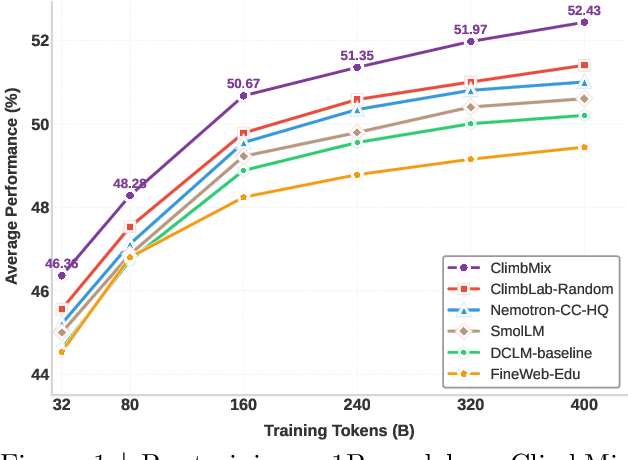

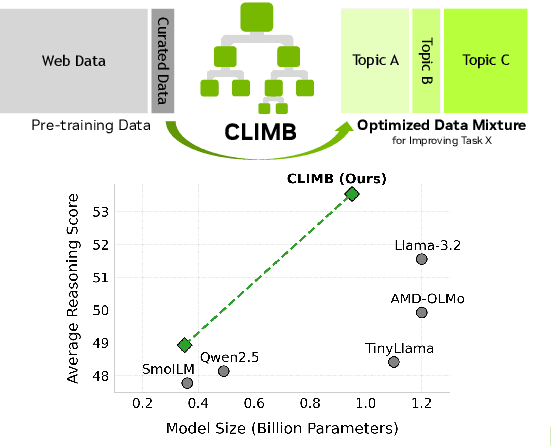
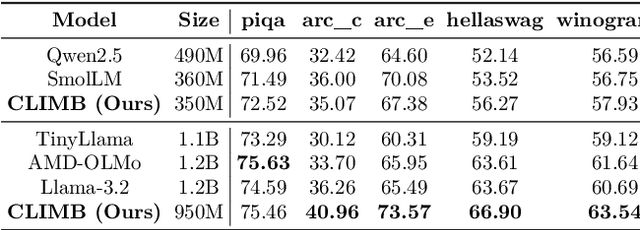
Abstract:Pre-training datasets are typically collected from web content and lack inherent domain divisions. For instance, widely used datasets like Common Crawl do not include explicit domain labels, while manually curating labeled datasets such as The Pile is labor-intensive. Consequently, identifying an optimal pre-training data mixture remains a challenging problem, despite its significant benefits for pre-training performance. To address these challenges, we propose CLustering-based Iterative Data Mixture Bootstrapping (CLIMB), an automated framework that discovers, evaluates, and refines data mixtures in a pre-training setting. Specifically, CLIMB embeds and clusters large-scale datasets in a semantic space and then iteratively searches for optimal mixtures using a smaller proxy model and a predictor. When continuously trained on 400B tokens with this mixture, our 1B model exceeds the state-of-the-art Llama-3.2-1B by 2.0%. Moreover, we observe that optimizing for a specific domain (e.g., Social Sciences) yields a 5% improvement over random sampling. Finally, we introduce ClimbLab, a filtered 1.2-trillion-token corpus with 20 clusters as a research playground, and ClimbMix, a compact yet powerful 400-billion-token dataset designed for efficient pre-training that delivers superior performance under an equal token budget. We analyze the final data mixture, elucidating the characteristics of an optimal data mixture. Our data is available at: https://research.nvidia.com/labs/lpr/climb/
Nemotron-H: A Family of Accurate and Efficient Hybrid Mamba-Transformer Models
Apr 10, 2025

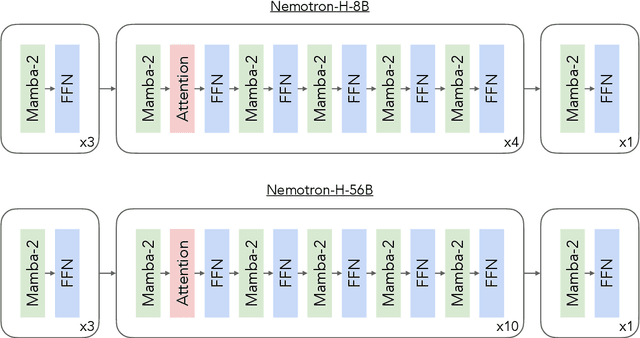
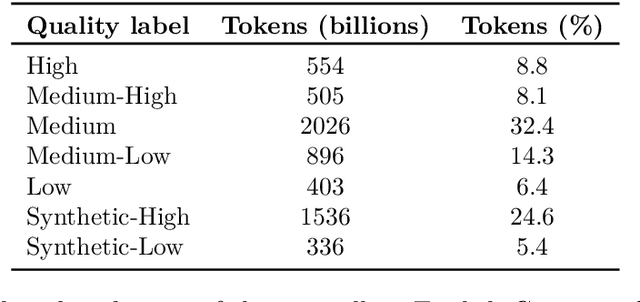
Abstract:As inference-time scaling becomes critical for enhanced reasoning capabilities, it is increasingly becoming important to build models that are efficient to infer. We introduce Nemotron-H, a family of 8B and 56B/47B hybrid Mamba-Transformer models designed to reduce inference cost for a given accuracy level. To achieve this goal, we replace the majority of self-attention layers in the common Transformer model architecture with Mamba layers that perform constant computation and require constant memory per generated token. We show that Nemotron-H models offer either better or on-par accuracy compared to other similarly-sized state-of-the-art open-sourced Transformer models (e.g., Qwen-2.5-7B/72B and Llama-3.1-8B/70B), while being up to 3$\times$ faster at inference. To further increase inference speed and reduce the memory required at inference time, we created Nemotron-H-47B-Base from the 56B model using a new compression via pruning and distillation technique called MiniPuzzle. Nemotron-H-47B-Base achieves similar accuracy to the 56B model, but is 20% faster to infer. In addition, we introduce an FP8-based training recipe and show that it can achieve on par results with BF16-based training. This recipe is used to train the 56B model. All Nemotron-H models will be released, with support in Hugging Face, NeMo, and Megatron-LM.
Disambiguation of Chinese Polyphones in an End-to-End Framework with Semantic Features Extracted by Pre-trained BERT
Jan 02, 2025



Abstract:Grapheme-to-phoneme (G2P) conversion serves as an essential component in Chinese Mandarin text-to-speech (TTS) system, where polyphone disambiguation is the core issue. In this paper, we propose an end-to-end framework to predict the pronunciation of a polyphonic character, which accepts sentence containing polyphonic character as input in the form of Chinese character sequence without the necessity of any preprocessing. The proposed method consists of a pre-trained bidirectional encoder representations from Transformers (BERT) model and a neural network (NN) based classifier. The pre-trained BERT model extracts semantic features from a raw Chinese character sequence and the NN based classifier predicts the polyphonic character's pronunciation according to BERT output. In out experiments, we implemented three classifiers, a fully-connected network based classifier, a long short-term memory (LSTM) network based classifier and a Transformer block based classifier. The experimental results compared with the baseline approach based on LSTM demonstrate that, the pre-trained model extracts effective semantic features, which greatly enhances the performance of polyphone disambiguation. In addition, we also explored the impact of contextual information on polyphone disambiguation.
* Accepted at INTERSPEECH 2019
Maximize Your Data's Potential: Enhancing LLM Accuracy with Two-Phase Pretraining
Dec 18, 2024



Abstract:Pretraining large language models effectively requires strategic data selection, blending and ordering. However, key details about data mixtures especially their scalability to longer token horizons and larger model sizes remain underexplored due to limited disclosure by model developers. To address this, we formalize the concept of two-phase pretraining and conduct an extensive systematic study on how to select and mix data to maximize model accuracies for the two phases. Our findings illustrate that a two-phase approach for pretraining outperforms random data ordering and natural distribution of tokens by 3.4% and 17% on average accuracies. We provide in-depth guidance on crafting optimal blends based on quality of the data source and the number of epochs to be seen. We propose to design blends using downsampled data at a smaller scale of 1T tokens and then demonstrate effective scaling of our approach to larger token horizon of 15T tokens and larger model size of 25B model size. These insights provide a series of steps practitioners can follow to design and scale their data blends.
Nemotron-CC: Transforming Common Crawl into a Refined Long-Horizon Pretraining Dataset
Dec 03, 2024Abstract:Recent English Common Crawl datasets like FineWeb-Edu and DCLM achieved significant benchmark gains via aggressive model-based filtering, but at the cost of removing 90% of data. This limits their suitability for long token horizon training, such as 15T tokens for Llama 3.1. In this paper, we show how to achieve better trade-offs between accuracy and data quantity by a combination of classifier ensembling, synthetic data rephrasing, and reduced reliance on heuristic filters. When training 8B parameter models for 1T tokens, using a high-quality subset of our data improves MMLU by 5.6 over DCLM, demonstrating the efficacy of our methods for boosting accuracies over a relatively short token horizon. Furthermore, our full 6.3T token dataset matches DCLM on MMLU, but contains four times more unique real tokens than DCLM. This unlocks state-of-the-art training over a long token horizon: an 8B parameter model trained for 15T tokens, of which 7.2T came from our dataset, is better than the Llama 3.1 8B model: +5 on MMLU, +3.1 on ARC-Challenge, and +0.5 on average across ten diverse tasks. The dataset is available at https://data.commoncrawl.org/contrib/Nemotron/Nemotron-CC/index.html
DurIAN-E 2: Duration Informed Attention Network with Adaptive Variational Autoencoder and Adversarial Learning for Expressive Text-to-Speech Synthesis
Oct 17, 2024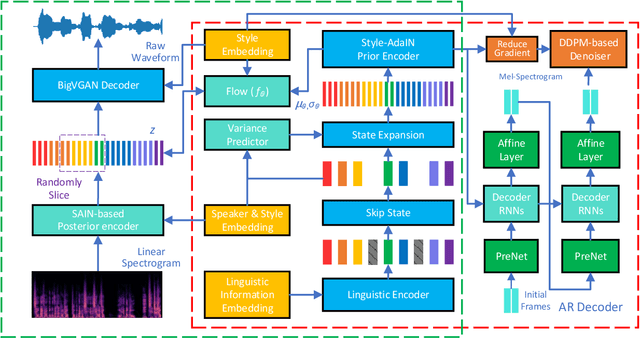
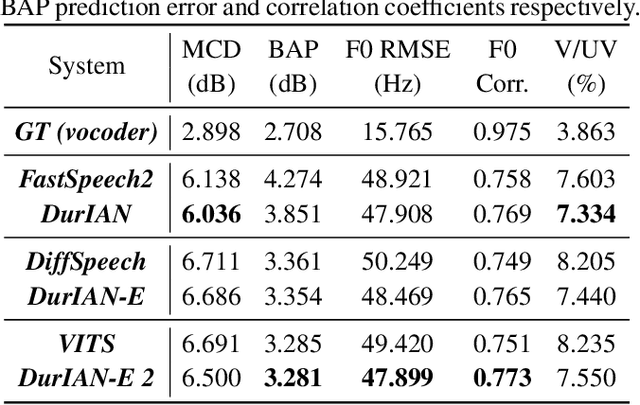
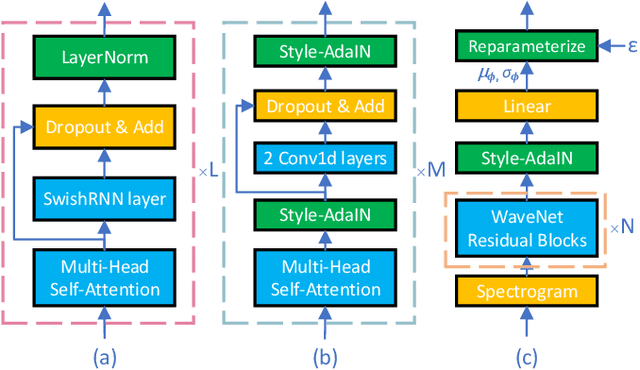

Abstract:This paper proposes an improved version of DurIAN-E (DurIAN-E 2), which is also a duration informed attention neural network for expressive and high-fidelity text-to-speech (TTS) synthesis. Similar with the DurIAN-E model, multiple stacked SwishRNN-based Transformer blocks are utilized as linguistic encoders and Style-Adaptive Instance Normalization (SAIN) layers are also exploited into frame-level encoders to improve the modeling ability of expressiveness in the proposed the DurIAN-E 2. Meanwhile, motivated by other TTS models using generative models such as VITS, the proposed DurIAN-E 2 utilizes variational autoencoders (VAEs) augmented with normalizing flows and a BigVGAN waveform generator with adversarial training strategy, which further improve the synthesized speech quality and expressiveness. Both objective test and subjective evaluation results prove that the proposed expressive TTS model DurIAN-E 2 can achieve better performance than several state-of-the-art approaches besides DurIAN-E.
Nemotron-4 340B Technical Report
Jun 17, 2024



Abstract:We release the Nemotron-4 340B model family, including Nemotron-4-340B-Base, Nemotron-4-340B-Instruct, and Nemotron-4-340B-Reward. Our models are open access under the NVIDIA Open Model License Agreement, a permissive model license that allows distribution, modification, and use of the models and its outputs. These models perform competitively to open access models on a wide range of evaluation benchmarks, and were sized to fit on a single DGX H100 with 8 GPUs when deployed in FP8 precision. We believe that the community can benefit from these models in various research studies and commercial applications, especially for generating synthetic data to train smaller language models. Notably, over 98% of data used in our model alignment process is synthetically generated, showcasing the effectiveness of these models in generating synthetic data. To further support open research and facilitate model development, we are also open-sourcing the synthetic data generation pipeline used in our model alignment process.
Generative Pre-trained Speech Language Model with Efficient Hierarchical Transformer
Jun 03, 2024
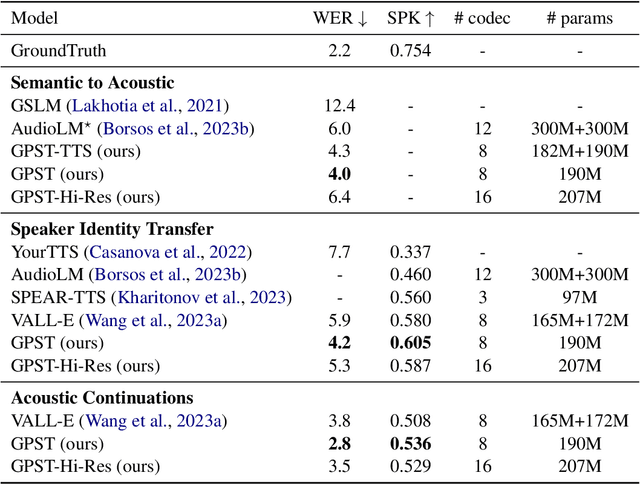
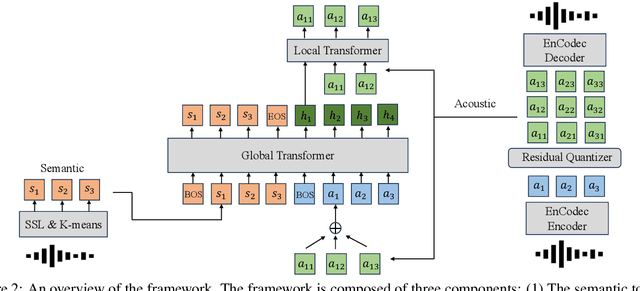
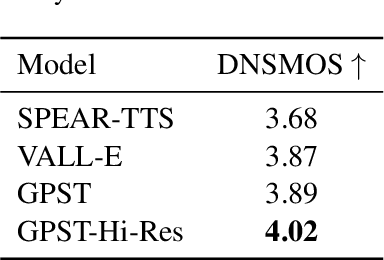
Abstract:While recent advancements in speech language models have achieved significant progress, they face remarkable challenges in modeling the long acoustic sequences of neural audio codecs. In this paper, we introduce \textbf{G}enerative \textbf{P}re-trained \textbf{S}peech \textbf{T}ransformer (GPST), a hierarchical transformer designed for efficient speech language modeling. GPST quantizes audio waveforms into two distinct types of discrete speech representations and integrates them within a hierarchical transformer architecture, allowing for a unified one-stage generation process and enhancing Hi-Res audio generation capabilities. By training on large corpora of speeches in an end-to-end unsupervised manner, GPST can generate syntactically consistent speech with diverse speaker identities. Given a brief 3-second prompt, GPST can produce natural and coherent personalized speech, demonstrating in-context learning abilities. Moreover, our approach can be easily extended to spoken cross-lingual speech generation by incorporating multi-lingual semantic tokens and universal acoustic tokens. Experimental results indicate that GPST significantly outperforms the existing speech language models in terms of word error rate, speech quality, and speaker similarity. See \url{https://youngsheen.github.io/GPST/demo} for demo samples.
 Add to Chrome
Add to Chrome Add to Firefox
Add to Firefox Add to Edge
Add to Edge